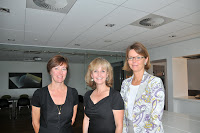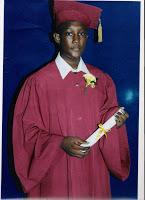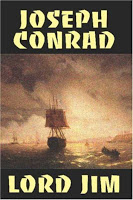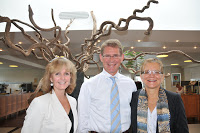From Diabetes to Hemophilia
Novo Nordisk is best known throughout the world as the leading manufacturers of insulin to treat diabetes; in the hemophilia community, it is best known for NovoSeven®RT, an inhibitor bypassing agent, a miracle drug to many. (Photo: with Lars Sørensen and Stephanie Seremetis)
I visited Novo Nordisk’s headquarters in Copenhagen, Denmark on Friday, to speak with CEO Lars Rebien Sørensen, arguably the most famous businessman in Denmark. The country is very small, about the size of my home state Massachusetts, and Novo Nordisk is its biggest company. Denmark is very pretty, a haven and heaven for cyclists, as everyone seems to bicycle everywhere. It doesn’t take long to get to Novo Nordisk from my hotel; indeed, it wouldn’t take long to get anywhere in this diminutive and charming country.
I am struck by how understated Novo Nordisk is. The buildings, designs, interiors are all minimalist, low key, humble even. Entering the executive suites, I am surprised to see that no one has offices per se; just desks, no walls, no glass, only hip-high borders to segregate one work area from another. Quite the opposite of the US and most other places, where executives usually prefer to have corner offices with glass, big cherry furniture, and doors for privacy. Here, everything is open, transparent.
Lars Sørensen came to the US in March (see blog.kelleycom.com/2010/03/spotlight-on-inhibitors-novo-nordisk.html#comments) to meet for the first time the key opinion leaders in the hemophilia community, and to also meet some patients. This meeting now was to follow up on points we touched upon, including products in the pipeline and the company’s policies for international humanitarian donations of product.
I first had lunch with Lise Kingo, executive vice president, Corporate Relations, and Charlotte Ersbøll, corporate vice president, who graciously filled me in on their programs. Next, a meeting with Charlotte and Trine Thomsen; Trine is heading the HERO project, a massive multicounty research that will attempt to quantify and publish responses about the psychosocial aspects of life with hemophilia. (Watch our blog for more news about this)
Last, a meeting with Lars and Dr. Stephanie Seremetis, formerly with a New York HTC. I had heard of Stephanie for so many years and each of us couldn’t quite believe we had never yet met! Lars is an energetic and welcoming executive, and we spoke for an hour about:
1. New products. We spelled out some of Novo Nordisk’s new products in research in the February issue of PEN: long-acting FVIIa; recombinant FVIII (to take on Advate and now Xyntha); a long-acting rFIX product; and a FXIII (13) product. We spoke about causes of inhibitors, patients’ personal experiences and what physicians are requesting (nonimmunogenic factor VIII—in other words, factor that does not cause inhibitors, although it’s not clear yet if how and why factor causes inhibitors)
2. Hemophilia in developing countries. One of my passions is to increase product donations to developing countries, and Novo Nordisk as of yet is not a big donor—although they donate a lot of product in the US, its main market. One problem is production itself: a specialty product for such a rare complication of such a rare disorder means not a whole lot of product sits on the shelf anywhere in the world. In other words, there isn’t much to donate. At Project SHARE we are over the moon when a rare donation of NovoSeven reaches us from some patient, HTC or homecare company, and usually it’s only a few boxes. It will be a while before donations become a routine thing and for now we will be dependent on third parties who donate NovoSeven to us. Novo Nordisk supports Project SHARE’s operating expenses, as do quite a few other pharmaceutical companies and others, and for this we are glad, but we look forward to the day when we and others can also expect product donations.
One interesting insight is Novo Nordisk’s take on product donations. As you can imagine, donating tons of products (just like doling out money to charities without expectation of anything in return) into a poor country can lead to dependency, which only perpetuates a bad situation; this is a constant threat to donations of anything in the humanitarian field. Lars explained that right now, the Novo Nordisk diabetes model has been extremely successful throughout the developing world, and perhaps this is the model to be followed in the future with hemophilia, when emerging markets like India and China start to purchase products. In diabetes, Novo Nordisk’s biggest single financial commitment is its annual donation to the World Diabetes Foundation. At the company’s Annual General Meeting in 2002, the shareholders made an agreement obliging the company over a 10-year period to make an annual donation of 0.25% of the net insulin sales for the preceding financial year (not to exceed approximately $12 million or 15% of taxable income).
In diabetes, the company’s donation policy is tied to product sales: higher sales mean a higher donation to the World Diabetes Foundation, and you can see where this would make good business sense. Also, clinics get established in this model; I saw some of these while traveling in Africa this year. Novo Nordisk is big in Africa, and does a lot to help those with diabetes.
In hemophilia, Novo Nordisk donates about $3 million to the Novo Nordisk Haemophiia Foundation (NNHF). NNHF supports sustainable local and regional projects as well as the advancement of relations between healthcare professionals, patient associations and authorities within the hemophilia community.
In hemophilia, a model like the diabetes model will take a long time to develop. But there are signs: patients in developing countries are integrating and speaking up like never before, thanks to information’s and resource exchange on the internet, and entities like the World Federation of Hemophilia, which brings patients, physicians and nonprofits together to learn and network, and to institute programs that train medical staff. Even at Project SHARE we sometimes, often, dangle product donations like a carrot to get patients organized and to take action. It works, no doubt. But people are still dying, weekly, and we will always need to donate life-saving products with no strings attached sometimes.
Hemophilia is a rare disorder, an expensive one, and we are a small community. Changing the current situation in poor countries will take a long time, and I plan to stick around for as long as humanly possible to ensure that change happens. Just so happens that Novo Nordisk’s slogan is “Changing Possibilities in Haemophilia®” and that needs to be believed no where more importantly than in hemophilia, by the patients, governments, humanitarians and very companies that provide the product.  (Photo: Hartnell of Jamaica, who died of inhibitor complications in August 2009 at age 20)
(Photo: Hartnell of Jamaica, who died of inhibitor complications in August 2009 at age 20)
Thanks to Lars and his team for welcoming me, for partnering with us, for sharing so much of their time and ideas. Let’s count on changing possibilities in the near future and make some dreams come true for those patients in countries where no treatment is available now.
Great Book I Just Read
Lord Jim
By Joseph Conrad
This classic was the basis for the movie “Apocalypse Now.” A young sailor, Jim, runs from his past by taking job after mundane job in far ports in the 1800s. He had served as first mate on the Patna, a ship carrying 800 Muslim pilgrims, which hit something in the dark waters one night during his watch and threatened to sink. Jim and the rest of the crew abandoned ship, thinking there is no hope of saving the passengers. The ship does not sink, and when Jim and the crew are rescued, their reputations are ruined. This story within a story is narrated by Marlow, an old sailor, who is fascinated by Jim, and spends the rest of his life trying to help the young man find redemption. Eventually Jim is offered a job to run a trading post in the far reaches of Southeast Asia, so remote few white people have ever visited. Eventually, his leadership and good deeds earns him the title “Lord Jim,” and he is beloved by the people. Soon his honor and character are tested as never before, earning him a last chance at redemption. The writing is amazing, the structure complex, superb, but difficult: some paragraphs are three pages long, and the story within a story can be confusing at times (think of the movie “Inception”!), but a great read; not to be missed. Four stars.


